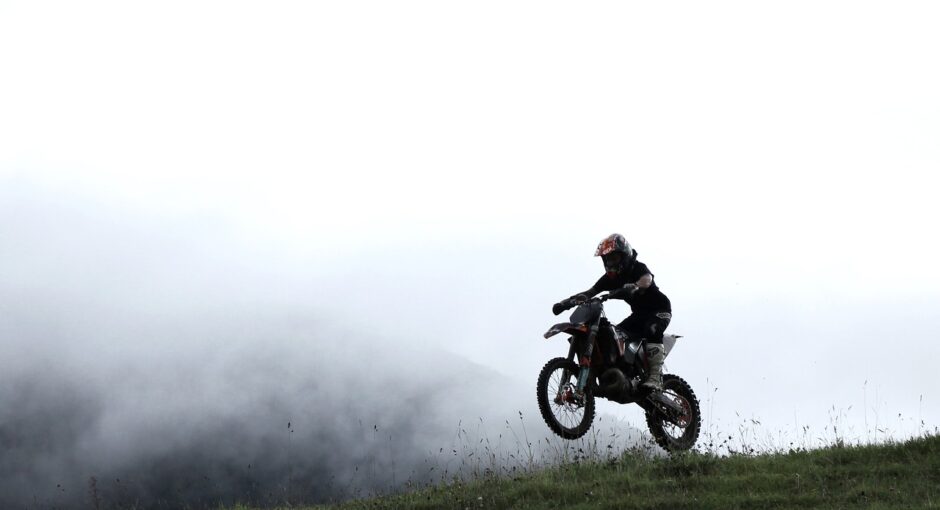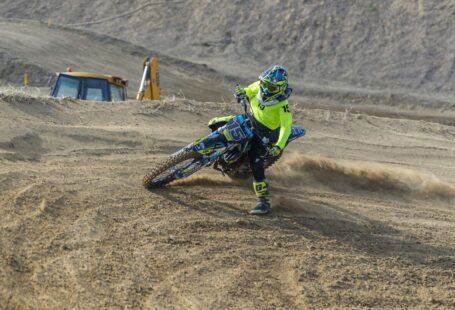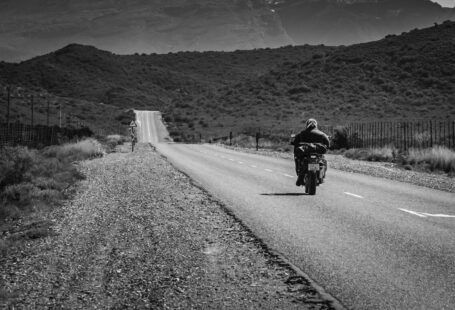Find a local course that has dirt bike riding classes. Your best bet is to go through the Motorcycle Safety Foundation Dirt Bike School. They offer courses nationwide specifically for beginners. Their courses provide bikes and riding gear on site. Use their website to sign up for a class near you.
- Beginner courses generally cost $125 and last six hours.
- MSF offers the most widely available dirt bike classes. If there isn’t one in your area, use a reputable search engine to find a course through another organization. You can find a course through a local motorcycle dealer too.
- Take beginner courses as many times as you want. You should feel comfortable and confident on a dirt bike before moving forward. Once you feel comfortable, try a more advanced class.
Find a local track or trail and practice on your own. Use this directory and talk to your instructor and fellow students about local tracks and trails to practice on. Some tracks have bikes you can rent, but for others you have to bring your own. Part 2 has information on how to buy a bike.
- Practice basic riding skills like using the front and back breaks, using the clutch, and navigating bumpy terrain. Work on riding in different conditions like rain and mud, and learn how to navigate whoops, dips, and jumps. Move up to more advanced skills like wheelies and power slides. Remember, practice makes perfect!
Ride with a group! Make friends in your classes and at the tracks. The motocross community is a welcoming bunch, especially for beginners. Organize outings and ride together. Doing motocross with friends will be a much more enriching and fun experience.
- There are plenty of motocross clubs out there. Go to a reputable search engine and search for ‘motocross clubs near me’. If there is one, reach out to them about joining! They’ll show you the ropes and give you people to ride with.
- Try to find people around your skill level to practice with. Have some playful competition with them!
Go to a race with your new motocross friends. Make a day of it and enjoy the spectacle that is motocross. Take note of the riders’ gear and technique. Learn the names and sponsors of the best racers. Above all else, have fun!
Part 2
Learning the Technique
- Practice driving straight. Your dirt bike will feel “wiggly” at first. The little grooves in the loose dirt will drag your front wheel back and forth. That’s natural. As you get to higher speeds, your front wheel will straighten out. Don’t tense up. Get a feel for going straight.
- Start in a low gear and work your way up.
- At faster speeds, make sure your back is at a 45 degree angle and your arms are at a 90 degree angle. Standing up will act as additional suspension, which will give you more control.
- Once you get comfortable, practice accelerating. Body position is key for this. When you accelerate, your body will naturally get pushed back. Remember to stay forward. Keep your butt in the natural indentation where the seat meets the gas tank. Your hips should be directly over the foot pegs.
- Don’t fight the backward push by pulling on the handlebars. Instead, lean forward and press down on the foot pegs.
- When you brake, squeeze the gas tank with your legs to stay in position. The more force you press on the handlebars the less control you have. Use your legs to stay in the proper position.
- When turning, commit and stay in control. Stick your inside leg out and keep your outside elbow up. If you have to put your foot down to avoid crashing, do it. Keep pressure on the outside foot peg and keep your butt on the outside of the seat. This will give you more traction.
- Remember to brake and shift before you enter a turn. You want to concentrate fully on the corner and your line, not braking.
- If your bike doesn’t shift automatically, work on shifting quickly and in one motion. You should use the throttle, clutch, and shifter together, not separately.
- Navigate whoops and bumps by standing up. Again, your legs add extra suspension and control. Whoops are the most common place to crash, so take them cautiously. Go slow and steady to start. Keep your weight towards the back of the bike, and remember that your bike will get wobbly. The key is to ride through it.
Part 3
Buying Equipment
- Find a motorcycle dealer. Whether or not you already have a bike, your next step should be to find a quality dealer. Go to a reputable search engine and search for “motocross dealer near me.” Comb through the results and find a motorcycle dealership that specializes in motocross and has a good reputation.
- Don’t let them pressure you into buying anything. You’re just talking about motocross. The dealer is there for you as a resource first and a salesperson second.
- Build and maintain a relationship with your dealer.
- If you don’t like the first dealer or their shop, move on and find another. Not every dealer is right for you. They should be friendly, willing to help, and have a top-notch shop.
- Once you’re ready, go to your dealer and buy a bike. This is your most important decision. Do some research on the different kinds of bikes. Talk to your dealer and a find a bike that fits your personal needs. These are the questions to consider when buying a bike:
- How experienced are you? If you’re just starting, you should probably go for a smaller, four-stroke bike.
- How tall are you? Find a bike that suits your size. Especially if you’re a beginner, you need a bike that’s short enough to allow you to put both feet on the ground.
- How old are you? If you’re a teenager, you’ll want a 125cc-250cc bike. Adults should get 250cc-500cc bikes. Note that cc stands for cubic centimeters. The more cubic centimeters, the more power the bike has.
- How much time are you willing to put into maintenance? Different bikes require different amounts of care. Generally speaking, four-stroke bikes require more maintenance than two-stroke bikes.
- How much money are you willing to spend? Motocross is expensive. Bikes generally cost thousands of dollars. Used bikes cost significantly less. Find a bike that fits your budget. Remember that you have more expenses coming with other equipment and memberships.
- Buy the appropriate safety equipment. As the saying goes: dress for the crash, not the ride. In motocross, you will crash. Be prepared and get the right safety gear. This is the safety equipment you’ll need:
- Helmet. This is the most important piece of gear. Your helmet should be snug, but not uncomfortable. A full-face helmet is the safest type. Don’t skimp on your helmet.
- Goggles. Always wear goggles. Your primary concern here is comfort.
- Body armor. You’ll need chest and back protectors to prevent impact injuries to your body.
- Clothing. Long sleeve shirts are a requirement. Wear something thinner to stay cool. Jeans are fine to start with, but you should get racing pants eventually.
- Boots. You have to wear boots that cover the ankle. Make sure they’re comfortable and broken in.
- Gloves. Always wear a sturdy pair of motorcycle gloves.
- Elbow and knee pads. These are optional but highly recommended, especially for beginners.
- Find a way to transport your new bike and gear. You’ll need a way to move your bike from your home to wherever you ride. Your method of transportation depends on how many bikes you need to transport and what kind of transportation you already own.
- If you have a pickup truck, you’re set. Strap your bike or bikes down in your truck bed with tie-downs.
- If you have a trailer, hitch it to your car and put your bike in the trailer.
- If you don’t have a truck or a trailer, and you don’t want to buy one, the cheapest and safest option is to buy a dirt bike carrier. You can order one online or buy one from your dealer. This only works to transport one bike, however.



